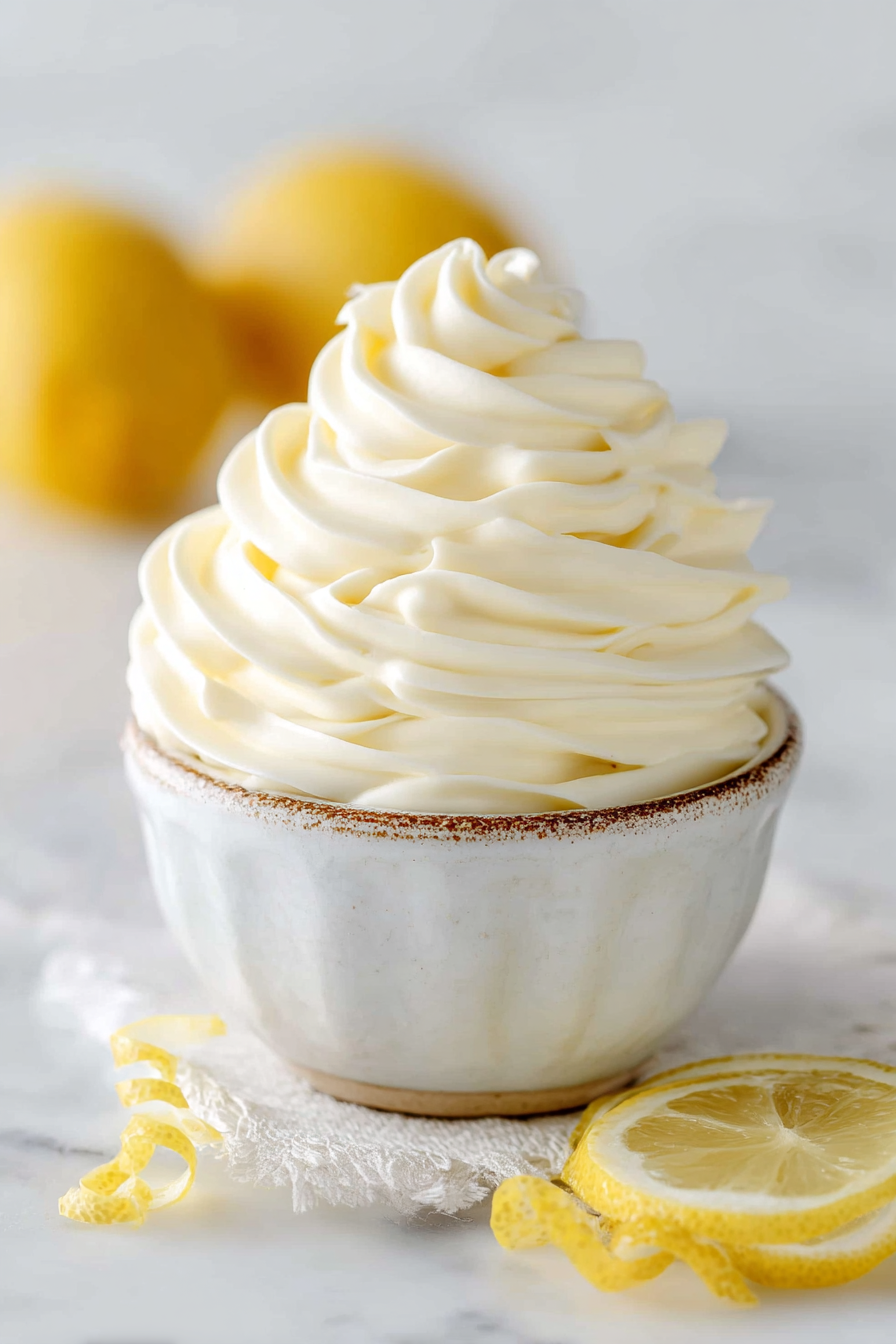Delish Lemon Ermine Frosting Recipes

There are recipes that wear their comfort on the sleeve — familiar, a little nostalgic, quietly satisfying — and then there’s lemon ermine frosting, which somehow feels like a sunny heirloom. It’s the kind of frosting that sits between light and indulgent: velvet-smooth, whisper-soft, with a gentle tang that wakes up the palate without shouting. I love it for the way it freshens up simple cakes and brightens an ordinary afternoon, and for the tiny bit of old-fashioned craft it asks for in return. Honestly, it makes everything feel like a slow Sunday, even if you only have an hour to spare.
My husband likes to joke that I make frosting more ceremoniously than I pack lunches, and I’ll admit he isn’t entirely wrong. One weekend morning I set up the bowls near the window where the light slants in like warm milk. He had a half-drunk cup of coffee on the counter and our youngest darted through the kitchen in socks, leaving a trail of giggles and a single rogue wallpaper sticker on the pantry door. The dog sat by the oven, blinking hopeful eyes, convinced a piece might fall for him. We played quiet music, and that citrus scent — bright, slightly floral, a little like the clean smell after rain — began to curl around the house. There’s this small, domestic magic to it: a bowl of something being coaxed into velvet, a child helping to press a spoon into a cake, a husband who insists on a little extra lemon because “it reminds me of your grandma.” Those are the moments that turn a recipe into a memory.
MORE OF OUR FAVORITE…
Why You’ll Love This Delish Lemon Ermine Frosting Recipes
There are a few gentle reasons I come back to this frosting over and over:
– It reads like texture heaven: airy, silky, with a whisper of body that makes it cling to cakes and biscuits without sliding off. When you lift a fork through it, there’s a soft, satisfying resistance and the sheen catches the light.
– The lemon lifts everything. It’s bright and clean, not cloying — you can taste sunshine and a touch of tartness, like a polite but eager hello on the tongue.
– It’s comfort with a touch of nostalgia. You get that old-fashioned, homestyle feel without anything heavy or overly sweet; it’s the kind of thing that warms up a kitchen and invites conversation.
– It’s versatile. Put it on a simple loaf cake on a weekday, dollop it on scones for a slow brunch, or frost an elegant layer cake for a celebration that doesn’t feel fussy.
Slow Moments
There’s something so calming about doing a bit of kitchen work that asks you to breathe and wait. I set out a small bowl, a wooden spoon that’s seen years of use, and I take those tiny, satisfying pauses: whisk, listen to the soft rhythm, and then stop to taste the rim. The house moves around me — a laundry cycle that finishes with a soft chime, the neighbor’s distant lawnmower, the creak of the back door where the dog sticks his head in to check progress. I like to stand by the window with the bowl and watch the light change as I stir; it’s almost meditative. Sometimes the rhythm is interrupted — a child wants help with a shoelace, a call comes through — and that’s part of it. The frosting is forgiving in that way; it rewards patience and light attention. When it comes together, there’s a private little triumph: the surface becomes glossy, the perfume of lemon floats higher, and everything feels, for a moment, a bit more settled.
Time-Saving Hacks
– Make the base the evening before and keep it chilled; it deepens the flavor with very little extra effort the next day.
– Zest your citrus ahead of time and store it in a small airtight container in the fridge — such a tiny prep step saves minutes and keeps things tidy.
– Use a stand mixer or hand mixer briefly to get that silky texture faster, then finish by hand for a homey touch.
– If you’re short on time, frost a loaf or cupcakes instead of a multi-layer cake; the presentation still feels special but requires less assembly.
– A calm reminder: a little slowing down — even just five minutes of quiet whisking — often improves the result. I promise it’s worth the pause.
Serving Ideas
– Weeknight warmth: spread a thin layer over sliced banana bread, or smear it over warm scones straight from the oven. Serve with black coffee or a mug of tea that’s been steeped a bit longer than usual.
– Weekend lingering: frost a light lemon layer cake and scatter fresh berries on top, or serve alongside shortbread cookies and a carafe of iced tea for an easy afternoon gathering.
– Sweet-sour pairing: pair with roasted fruit — think sliced peaches or pineapple grilled until caramelized — the contrast is quietly joyful.
– For a cozy brunch, serve with scrambled eggs and a small platter of cured meats and pickles to balance the bright sweetness.
– Complementary recipes: sometimes I’ll pull a simple pound cake from the pantry and add this frosting as an upgrade — it feels celebratory without fuss. For more ideas, I often wander the site at https://mychillirecipes.com/ for inspiration.
Tips & Mistakes
Be gentle with expectations. I once tried to rush the process by heating things at higher temperature; I ended up with a frosting that tasted rounded but a little flat in texture. Since then I’ve learned that slow, steady warmth and patient whisking make a world of difference. Watch for temperature — not too hot, not too cold — when you bring components together; that’s often where things separate or become grainy. If lumps appear, I’ll quietly smile, scoop it into the bowl of the mixer, and whisk through them; more often than not, it smooths out. And if you’re tempted to over-sweeten, start with less; you can always brighten with more lemon. My husband once demanded a “super lemon” version and we both ended up puckering with delight — a funny reminder that balance is everything.
Storage Tips
Leftovers keep nicely in the fridge in an airtight container for a few days. I like to bring a chilled frosting to room temperature before spreading — it loosens up and becomes almost pillowy again. If you’ve frosted a cake and have extras, try using the remainder as a weekend spread: on a muffin with your morning coffee or a thin smear on plain yogurt topped with granola. For longer storage, it can be frozen in a sealed container; thaw overnight in the refrigerator and then sit it out for an hour before using. There’s something cozy about a leftover slice the next morning, when the flavors have had a night to settle and the house is still half-sleeping.
Variations and Substitutions
I’ve played around with citrus swaps — lime brings a zesty brightness, orange gives a softer, almost marmalade note — and they’ve all been pleasant companions. A touch of vanilla rounds it out for those who prefer warmth over tang. I tried a lighter version once by easing back on the sugar and adding a drizzle of honey; it was softer and less bright, which worked well on denser cakes. For dairy-free attempts, I found that plant-based butter works, but the texture shifts slightly — still lovely, just a bit less luscious. I’ve resisted heavy add-ins; delicate herbs like a whisper of basil or thyme can be interesting in tiny amounts, but I usually keep the frosting itself simple and let other elements carry the twist.

Frequently Asked Questions

Delish Lemon Ermine Frosting Recipes
Ingredients
Main Ingredients
- 1 cup unsalted butter softened
- 2 cups granulated sugar
- 2 cups milk whole
- 1 tablespoon vanilla extract
- 1 cup fresh lemon juice
Instructions
Preparation Steps
- In a medium saucepan, combine the sugar and flour. Gradually whisk in the milk and cook over medium heat until thickened.
- Remove from heat and let cool. Then beat in the butter, vanilla, and lemon juice until smooth.
- Use immediately or refrigerate until ready to use.
